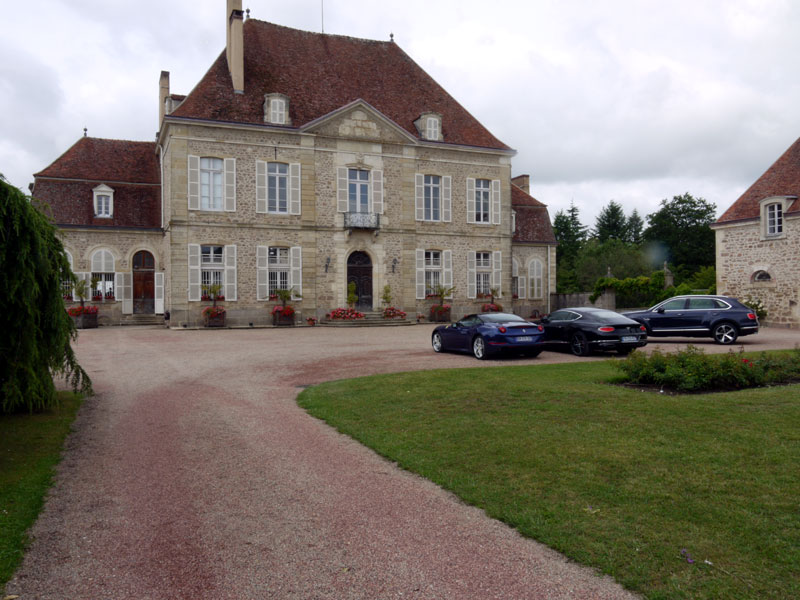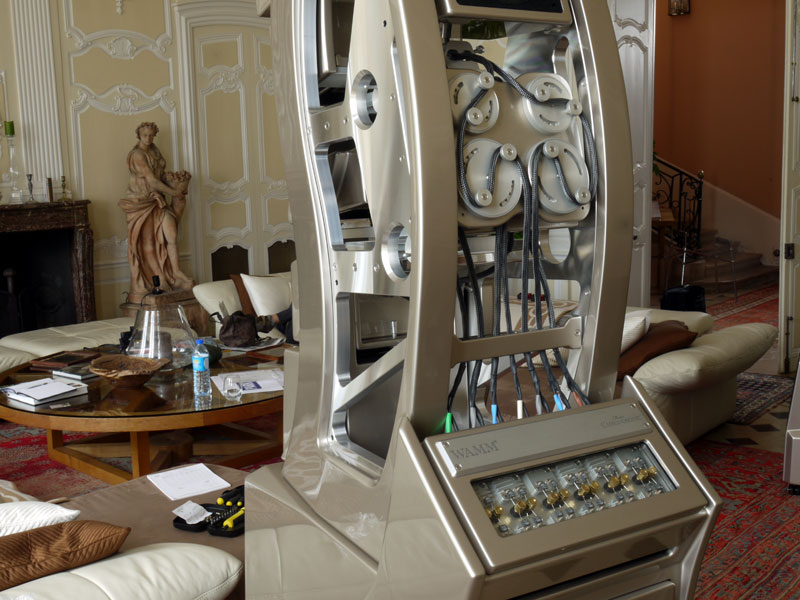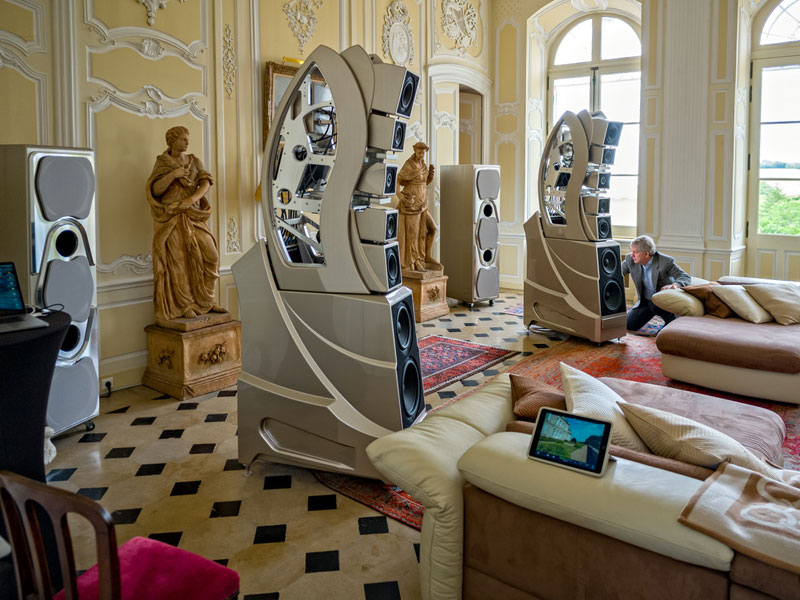Europe Audio Diffusion WAMM MC Event
or many audiophiles, the only chance to experience the most ambitious and extravagant products is through audio shows or dealer presentations. Yet, more often than not, the results fail to justify the hope and faith invested. Listening to or reading the comments of many visitors, the criticism is swingeing, the cynicism rampant. Of course, for the vast majority of us, actually owning those products is beyond our wildest dreams, a reality that I’m sure to some extent fuels the willingness to dismiss or belittle them. But it is also a situation that reflects two inconvenient truths. On the one hand, the audio industry still hasn’t discovered that magic formula for presenting its most aspirational products to those people who might actually buy them. On the other, when these products are presented, they rarely actually deliver the performance they’re capable of. There are exceptions. While a Wilson Audio WAMM Master Chronosonic (MC) road show rolls on its inexorable way northward across Europe, the recent presentation in France stands out as an object lesson, both in just how much effort, logistical complexity and sheer cost are involved in any such event, and also how to get it right. Wilson’s French distributor, Europe Audio Diffusion (EAD), is one of the company's oldest European partners. They started importing the likes of Audio Research and Magnepan as far back as 1976, bringing over their first Wilson speakers, the original WAMMs, in 1981, long before the appearance of the WATT in 1985. EAD’s founder, Philippe Demaret, has recently handed the company's reins to his son, but in a strange piece of historical congruence, he wanted to go out with a bang, and there are few bigger bangs than the Wilson WAMM MC ($850,000 per pair, with subwoofers). Philippe had a dream, a plan for the presentation of such a product, and there are few things as scary as a man with a plan and the means to realize it.
It helps that Europe Audio Diffusion is based in the small but elegant Chateau de Marrault, with offices and storage in the numerous outbuildings. Philippe lives in the main house, where he enjoys his Wilson Alexandria XLFs ($215,000 per pair) installed in the main salon and driven with Audio Research electronics -- Reference CD9 SE CD player ($15,000), Reference 10 line stage ($33,000) and Reference 160M mono amplifiers ($30,000 per pair) -- entirely installed, complete with Shunyata power conditioning and cables, in a storage wall hidden away in an adjacent corridor. When you see the room where the speakers are positioned -- dating from around 1730 -- you can understand why so much of the system is tucked out of sight. But even with the guidance of the preferred positioning for the Alexandria XLFs, installing the WAMM MCs, along with the matching Master Subsonic subwoofers ($100,000 per pair), was a monstrous, four-day undertaking, involving not just Peter McGrath and Bill Peugh from Wilson Audio, but Philippe and various members of the EAD team.
But while Wilson was investing four long days of concentrated effort on assembling and adjusting the speakers, the rest of the Chateau was being consumed in a whirlwind of associated activity, all intended to create the context (and attract a varied audience) for the speaker presentation. With almost forty years of Wilson sales to draw on, EAD has a significant database of existing customers, many of whom already use Alexandria XLFs.
But Philippe wanted to do more than simply show the new speaker. He wanted to create a sense of event, casting a wider net and reaching a broader audience -- one that already appreciated quality and performance in other areas. So rather than a simple speaker presentation, what he created was an extravagant open house, one that lasted all weekend and embraced and entertained not just his existing customers but a visit from the Bentley Owner’s Club, attracted by the French launch of the latest GT model. There was a display by legendary publishing house Taschen, including the recent David Hockney A Bigger Book and examples of the sought-after David Bailey and Helmut Newton editions. There was a Friday-evening jazz concert with the highly regarded Manual Rocheman Trio, glorious food provided by a Michelin-starred Parisian restaurant, and wines from local Burgundian vineyards.
Back to the speaker installation. The first order of business was to remove the XLFs -- thankfully a fairly straightforward task using the supplied casters. Then the multiple elements that go together to create the WAMM MC needed to be uncrated and laid out, the main speakers’ bass cabinets placed in a preliminary position and the substantial superstructures that support the midrange and treble units hoisted into place. After that the subs needed to be unboxed and positioned out of the way, awaiting their introduction later in the process. All told, that took the best part of a day.
Day two consisted of checking all the components that go into each speaker before carrying out the painstaking assembly, one channel at a time. This consists of taking initial measurements to assess which interface elements will be required to align each sub-cabinet, before installing the four separate assemblies into the superstructure, where they mate with the WAMM MC’s sophisticated rack-and-pinion mechanism. With the sub-cabinets installed, their cabling then needs to be dressed and attached to the main terminal block. That might not sound too challenging until you stop to consider the range of movement necessary to guarantee proper time alignment at listening distances that might be anything from nine to over twenty feet. In turn that requires considerable available length in the umbilicals that feed each of the sub-cabinets and the inevitable excess cable has to be carefully accommodated to avoid electrical or mechanical interference. A complex, dual-layer system of eccentric, rotating bosses is used to wind the excess cable and dress it for perfect presentation to the terminals. With everything wired up, the speakers can finally be fired up and left to run in an effort to help them recover from their travel shock.
Day three started with a complete reassessment of the initial speaker placement, the bass depth and weight having developed considerably overnight. In terms of actual positing, this involved movements of an inch or so fore and aft and between four and six inches sideways, before the speakers were lifted, using the supplied jack (with its extended ratchet handle) in order to replace the wheels with the spike assemblies, carefully ensuring that the overall height from the floor remained consistent. With the bass dialed in, it was time to start work on the final positioning of the sub-cabinets, using a combination of the manual’s exhaustive propagation-delay tables and a check back to the factory to run the final settings through the computer program that generated them. With the settings established, it was time to adjust the relative position of the head units using the slide-rule-like scales and rotary knobs that allow them to be moved precisely and independently. With so many moving parts it’s an exacting task just ensuring that the right settings are applied to the right driver and that the settings on both speakers are identical. With the speakers fully assembled and aligned, it was time to carry out two tedious but essential housekeeping tasks. First, the fixing bolts on all 18 drivers (don’t forget the rear-firing units) needed to be loosened and then retightened to their correct torque settings, in order to remove any chance of their working free in use or transit. Second, the pairs of padding resistors that sit beneath the glass panel on the rear of the speaker’s superstructure needed to be replaced with new components, in case they’ve been overdriven in use -- a not unlikely scenario, given the speakers’ busy schedule of presentations and shows. This last change was frankly astonishing, bringing a significant increase in dynamic range, focus and transparency -- and one that meant that as soon as I got home, swapping out the resistors on the Alexx was a priority.
Until now, the subwoofers had played no part in proceedings, but with the main speakers approaching final setup, it was time to add the extra bandwidth to the mix, with the Master Subsonic crossovers feeding a D’Agostino Progression stereo amplifier ($22,000). Once again, it was time to leave the system playing overnight to give everything a chance to bed in, allowing the final day to fine-tune woofer placement and crossover settings, as well as making final tweaks to the main speaker placement, a long, drawn-out process that involved repeated tiny shifts in the position of all four cabinets and, in particular, microscopic adjustments of the phase controls on the subwoofer crossovers, all essential to achieving the remarkable dimensionality, presence and lifelike dynamics that the WAMM MC can deliver. With the approaching arrival of the first guests looming, the final tweaks were completed, the grilles installed on the subwoofers (a clearly audible but aesthetically necessary compromise) and the system was ready to perform. With the competing attractions of fast cars, fine art and fine dining, you might wonder whether visitors (most of whom were couples) might be a little distracted, diluting the impact of the loudspeakers around which the event was constructed. But with such a relaxed and convivial atmosphere, and with all day to enjoy the various offerings, in fact the opposite was true. Audiophiles got to enjoy the car culture, just as the Bentley owners got to enjoy a truly great audio system -- a novel experience for most of them. But what really worked was just how naturally the extravagant Taschen books and gourmet food, the luxury cars and the high-end audio system coexisted. The result was by far the most enjoyable and successful such event I’ve ever attended, with a return both in terms of appreciation from existing customers, fascination from those new to high-end audio and, at the end of the day, most importantly of all, actual orders. Those sales justified Philippe’s faith in his approach -- and financially and organizationally, it really was a leap of faith. But what I took from the experience was not just a renewed appreciation for the sheer effort that goes into such an event (as well as the often considerable challenges that need to be overcome -- moving something this heavy, perched on four spikes and standing on a mixture of antique carpet and 300-year-old parquet is no small thing) but confirmation that audio can coexist with other high-profile, performance-orientated pursuits and products -- as long as it does so on that basis, performance. While existing Wilson owners arrived clutching favorite discs and were duly impressed by their replay, far more memorable was the sheer astonishment and bemused pleasure that registered on the faces of non-audiophiles, hearing familiar tracks from the likes of Lou Reed or the Rolling Stones, hearing them in such remarkable surroundings and hearing such remarkable reproduction. Will those people buy WAMM MCs? Probably not (at least not yet), but I foresee a lot of Sasha DAW sales in the not-too-distant future.
If events like this are the only opportunity
that most of us ever have to engage with genuinely state-of-the-art products, then, as an
industry, high-end audio needs to ensure that these events do actually engage.
But if manufacturers commit to the work and investment involved, the results and returns
will justify their efforts. For high-end audio to command attention and commitment, it
needs, above all else, to deliver high-end performance -- and that’s exactly what
Wilson Audio, EAD and their partners achieved. |








